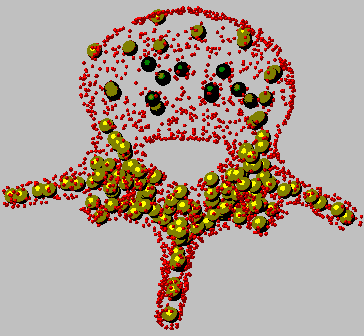View current page
...more recent posts
More commentary on the 2007-2008 Rhizome.org commissions Considered as XYZ Art post. People aren't offering any specific examples of where the analysis fails, they're mostly just telling me to shut up.
you could also apply the XYZ method to art criticism: take artwork X, apply categorization schema Y, produce art review Z.
- anonymous (guest) 6-21-2007 3:52 pm
You could, but some specifics would help.
I'm not sure there are any categorization schema any more except the old reliable, "mere description."
- tom moody 6-21-2007 4:46 pm
Right. Then why are you using the XYZ schema to critique art? As a critical process, it is more reductionist than the creative processes that you are criticizing.
- anonymous (guest) 6-21-2007 5:12 pm
Well, we disagree, there.
I'm flattered if you think XYZ is a critical methodology, or as you say "categorization schema."
I think the point of your comments is that it would be better not to question the Rhizome commissions.
Either that or there are so many other ways of critiquing them being articulated out there that mine should be disregarded as the weakest alternative.
R--i-i-ight.
- tom moody 6-21-2007 6:02 pm








































































GIF by unknown artist X 72
Every Enemy is Al Qaeda Now
Bush and the U.S. press continue their collusive spin thing. Glenn Greenwald in Salon (may be behind subscription firewall):
That the Bush administration, and specifically its military commanders, decided to begin using the term "Al Qaeda" to designate "anyone and everyone we fight against or kill in Iraq" is obvious. All of a sudden, every time one of the top military commanders describes our latest operations or quantifies how many we killed, the enemy is referred to, almost exclusively now, as "Al Qaeda."
But what is even more notable is that the establishment press has followed right along, just as enthusiastically. I don't think the New York Times has published a story about Iraq in the last two weeks without stating that we are killing "Al Qaeda fighters," capturing "Al Qaeda leaders," and every new operation is against "Al Qaeda."
The Times -- typically in the form of the gullible and always-government-trusting "reporting" of Michael Gordon, though not only -- makes this claim over and over, as prominently as possible, often without the slightest questioning, qualification, or doubt. If your only news about Iraq came from The New York Times, you would think that the war in Iraq is now indistinguishable from the initial stage of the war in Afghanistan -- that we are there fighting against the people who hijacked those planes and flew them into our buildings: "Al Qaeda."










































Compare and contrast:
Kristin Lucas, Host, 1997 (Quicktime excerpt clickable here [not anymore--thanks EAI!!!], or rather, here)
and
Paul Slocum, Hats, 2007 (YouTube)
Update: 12 hours later, and none of you have turned in your essays. I think these pieces are very similar and say much about the media (and assumptions about media) prevalent at the time they were made.
1. Both take place within a screen space, with inset headshot windows, and involve two characters talking (or not) at cross purposes to each other.
2. The Lucas is a quasi-science fiction scenario playing on the Logan's Run/THX1138 trope of the "video confessional." Lucas tells her troubles to an ATM camera, but instead of Big Brother or Sister, an overworked, headset-wearing operator (also Lucas) mostly ignores her while putting out fires on other networks. POVs are looking out from the ATM at the patient/confessor on the street, the operator/shrink on an inset screen, and an awkward exchange where the shrink tries to tell the patient where to touch the screen to get a response.
3. In Slocum's piece the action takes place on a present-day, cluttered computer desktop. Two video inset windows frame Slocum and another character, who might be videoconferencing. The headset-wearing Slocum is mostly just listening and lurking, opening and closing desktop windows as the page strains from the taxing of memory. He recalls the "operator" in the Lucas video, managing chaos and not accomplishing much. The other character is not a penitent from the street but a guy on YouTube confessing his girlfriend problems, and not to Slocum but the world. His voice cuts in and out and repeats.
4. 1997: closed network, centrally controlled, falling apart from an absence of qualified human "controllers," yet there is still faith in the system by the users.
5. 2007: open network, peer to peer, but communication no better--YouTube is a one way confession, screen is clogged with noise of too many cyberentertainment distractions. Users still think confessing (to a social networking site) will solve their problems.
6. Both pieces are complex and layered and make adroit use their respective media to evoke maximum cognitive dissonance.
7. Both works introduce subject matter extraneous to a simple two character narrative. Lucas' operator appears to be splitting her time between her "confessional" clients and managing some sort of group videogame environment (this may not be apparent on the excerpted clip). The contours of her activities are porous and uncertain. Half of Slocum's screen space is taken up with a banal jpeg of baseball hats on an armchair, along with a confused multiplicity of windows opening and closing as well as overlapping and interrupting the YouTube boob.
8. In both works the artists use their own image as a character or characters.
9. Lucas's screen environment is wholly fictional, but Slocum's might actually just be his desktop on a given day, heaven help him.
10. Both pieces are further nested within screen environments reflective of their eras. Lucas is Amiga computer- and analog-mixed video for TV display (converted to Quicktime for the Web by the non-profit Electronic Arts Intermix, which distributes the work). The Slocum piece is all-PC, using capture programs and other software, self-distributed via the YouTube (centrally, corporately controlled) video networking site.
11. Both pieces are linked to from the artist's personal websites. Lucas's has an archive linking to excerpted versions of the work (update: a longer one is here); Slocum's is in blog form and puts an embedded YouTube of the video in a post.

Selected group websurfing blogs:
Double Happiness
Supercentral
Nasty Nets (disclosure: I'm in this)
The heirs to SCREENFULL and 544x378(WebTV)? The latter were daily blogs with original audio and visual work, now sadly archived, that were heavy on recycled/mashed Internet/pop culture content. I suspect it was hard for two people (jimpunk and Abe Linkoln) to sustain that creative pitch, but with a group blog the work is distributed more evenly. Whether they'll last any longer is another question. All have a certain ad hoc quality that keeps them unpredictable but Internet creative chemistry is so flighty. On the other hand, what happens with real-world co-ops is that one or two people end up doing all the work (and therefore laying down rules for the others) but low overhead and a low bar to participation makes the Internet model potentially different. Still, someone has to deal with the nightmare of comment spam and other realities of the internet, even if all costs are shared equally.
Update: There is something on the Nasty Nets front page that is either crashing my browser or prompting me to install non-existent Quicktime add-ons. I think it is the embedded "Mr Wizard" file. (I have Firefox on a PC.) It will soon be gone from the front page after a couple more posts. It would be good if this could be fixed because I have a commenter blaming an excess of animated GIFs for "harming" his computer--this completely killed any discussion of the content of the page.

